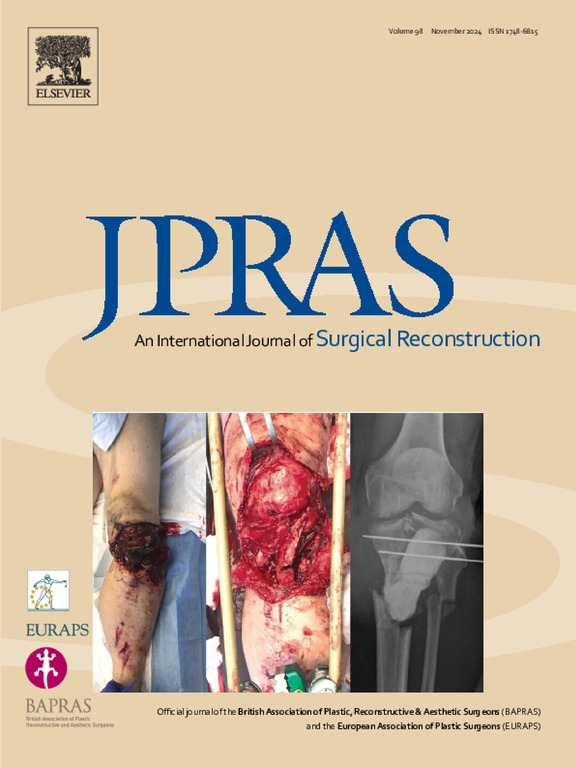Optimising breast implant replacement surgery: Benefits of systemic tranexamic acid on post-operative blood loss and drain time
IF 2
3区 医学
Q2 SURGERY
Journal of Plastic Reconstructive and Aesthetic Surgery
Pub Date : 2025-03-27
DOI:10.1016/j.bjps.2025.02.055
引用次数: 0
Abstract
Background
Minimising surgical bleeding is crucial for optimising outcomes in clinical practice. Tranexamic acid, an antifibrinolytic agent, has shown efficacy in various clinical fields and is receiving increased attention in plastic and aesthetic surgery. This study is the first to investigate the impact of systemic tranexamic acid on post-operative blood loss and bleeding complications in patients undergoing breast implant replacement with simultaneous capsulectomy for capsular contracture.
Methods
After introducing systemic administration of 1 g tranexamic acid during surgery as routine prophylaxis, 40 patients (80 breasts) receiving this treatment were retrospectively compared to a historic cohort of 20 patients (40 breasts) who did not. The evaluated outcome parameters included 24-hour and total drain fluid production, drain time, and absolute and relative decreases in haemoglobin and haematocrit levels on the first operative day. Furthermore, bleeding complications such as the need for blood transfusion and haematoma evacuation were assessed.
Results
Tranexamic acid significantly reduced drainage volume within the first 24 h (72 ml versus 95 ml, 24.2%) and total drain fluid production (189 ml versus 351 ml, 46.2%). Additionally, a significantly shorter drainage time (3.9 d versus 7.1 d, 45.1%) and decreased post-operative decline in haemoglobin and haematocrit levels were observed. Regarding post-operative bleeding complications, 1 haematoma occurred in the tranexamic acid group versus 2 in the control group.
Conclusion
Systemic administration of tranexamic acid effectively reduced post-operative blood loss and drain time in patients undergoing bilateral implant replacement surgery with capsulectomy.
优化乳房植入物置换手术:全身氨甲环酸对术后失血和引流时间的益处
背景:在临床实践中,减少手术出血对于优化结果至关重要。氨甲环酸是一种抗纤溶药物,已在临床的各个领域显示出疗效,并在整形和美容手术中受到越来越多的关注。本研究首次探讨了全身性氨甲环酸对因包膜挛缩而行乳房假体置换术并同时切除包膜的患者术后失血和出血并发症的影响。方法:在引入手术期间全身给予1g氨甲环酸作为常规预防治疗后,对40例(80个乳房)接受这种治疗的患者与20例(40个乳房)未接受这种治疗的患者进行回顾性比较。评估的结局参数包括24小时和总排液量、排液时间、手术第一天血红蛋白和红细胞压积水平的绝对和相对下降。此外,出血并发症,如需要输血和血肿清除评估。结果氨甲环酸显著降低了患者24 h内的排液量(72 ml比95 ml, 24.2%)和总排液量(189 ml比351 ml, 46.2%)。此外,引流时间明显缩短(3.9 d vs 7.1 d, 45.1%),术后血红蛋白和红细胞压积水平下降。关于术后出血并发症,氨甲环酸组发生1例血肿,对照组发生2例。结论全身应用氨甲环酸可有效减少双侧假体置换术伴囊切除术患者术后出血量和引流时间。
本文章由计算机程序翻译,如有差异,请以英文原文为准。
求助全文
约1分钟内获得全文
求助全文
来源期刊
CiteScore
3.10
自引率
11.10%
发文量
578
审稿时长
3.5 months
期刊介绍:
JPRAS An International Journal of Surgical Reconstruction is one of the world''s leading international journals, covering all the reconstructive and aesthetic aspects of plastic surgery.
The journal presents the latest surgical procedures with audit and outcome studies of new and established techniques in plastic surgery including: cleft lip and palate and other heads and neck surgery, hand surgery, lower limb trauma, burns, skin cancer, breast surgery and aesthetic surgery.

 求助内容:
求助内容: 应助结果提醒方式:
应助结果提醒方式:


